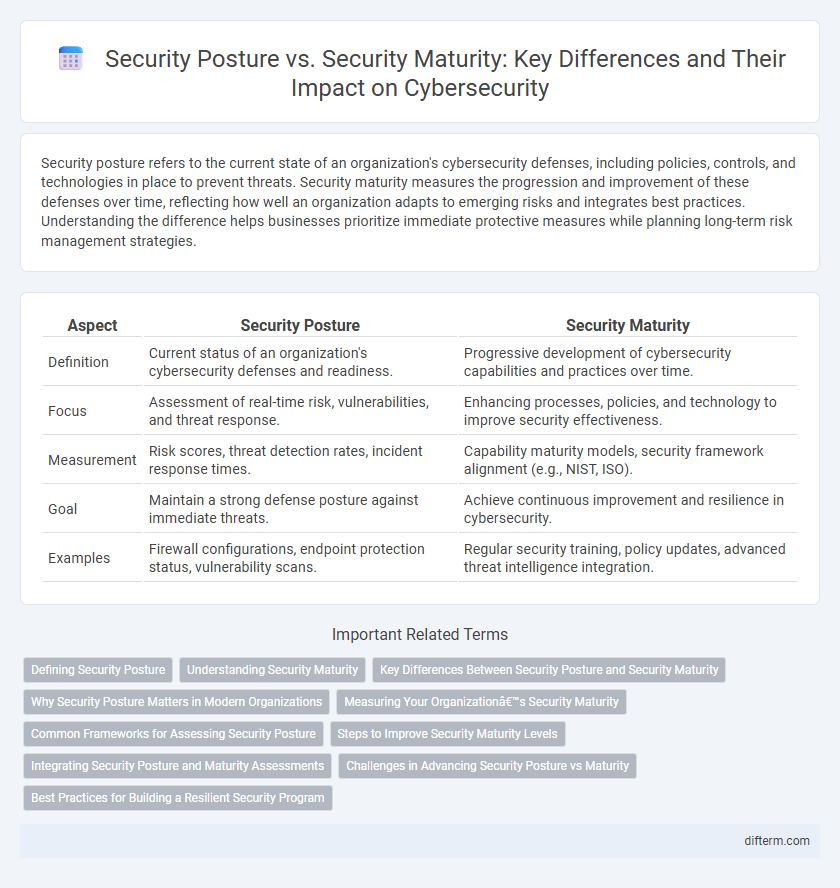Security posture refers to the current state of an organization's cybersecurity defenses, including policies, controls, and technologies in place to prevent threats. Security maturity measures the progression and improvement of these defenses over time, reflecting how well an organization adapts to emerging risks and integrates best practices. Understanding the difference helps businesses prioritize immediate protective measures while planning long-term risk management strategies.
Table of Comparison
| Aspect | Security Posture | Security Maturity |
|---|---|---|
| Definition | Current status of an organization's cybersecurity defenses and readiness. | Progressive development of cybersecurity capabilities and practices over time. |
| Focus | Assessment of real-time risk, vulnerabilities, and threat response. | Enhancing processes, policies, and technology to improve security effectiveness. |
| Measurement | Risk scores, threat detection rates, incident response times. | Capability maturity models, security framework alignment (e.g., NIST, ISO). |
| Goal | Maintain a strong defense posture against immediate threats. | Achieve continuous improvement and resilience in cybersecurity. |
| Examples | Firewall configurations, endpoint protection status, vulnerability scans. | Regular security training, policy updates, advanced threat intelligence integration. |
Defining Security Posture
Security posture refers to an organization's overall cybersecurity strength, encompassing policies, controls, and defenses deployed to protect against threats. It includes the assessment of vulnerabilities, risk management strategies, and incident response capabilities that collectively determine the readiness to prevent or mitigate cyberattacks. A robust security posture continuously evolves through monitoring, threat intelligence, and adaptation to emerging risks, providing a foundational measure of security effectiveness.
Understanding Security Maturity
Security maturity measures an organization's ability to proactively identify, manage, and improve cybersecurity practices over time, reflecting a dynamic progression beyond basic security posture implementation. It encompasses continuous risk assessment, adaptation to emerging threats, and integration of advanced security technologies and policies. Achieving higher security maturity ensures resilience against complex cyberattacks through systematic improvements and strategic security governance.
Key Differences Between Security Posture and Security Maturity
Security posture refers to the current state of an organization's cybersecurity defenses, encompassing policies, controls, and threat response capabilities. Security maturity assesses the evolution and sophistication of cybersecurity practices over time, highlighting continuous improvement and strategic alignment with industry standards. Key differences include posture being a snapshot of readiness, while maturity indicates progress and long-term resilience in managing security risks.
Why Security Posture Matters in Modern Organizations
Security posture represents an organization's current cybersecurity defenses and resilience against threats, highlighting real-time risk management capabilities. Security maturity, however, reflects the long-term development and continuous improvement of security processes and policies. Understanding and prioritizing security posture enables modern organizations to quickly identify vulnerabilities, respond to incidents, and maintain operational integrity in an evolving threat landscape.
Measuring Your Organization’s Security Maturity
Measuring your organization's security maturity involves assessing the effectiveness of security policies, controls, and incident response capabilities to identify gaps and prioritize improvements. Tools such as maturity models and continuous risk assessments provide quantifiable metrics that reflect the organization's progress toward a robust security posture. Regular evaluation of these metrics enables informed decision-making and alignment of security strategies with business objectives.
Common Frameworks for Assessing Security Posture
Common frameworks for assessing security posture include the NIST Cybersecurity Framework (CSF), ISO/IEC 27001, and the CIS Controls, each providing structured guidelines to evaluate and enhance security measures. These frameworks emphasize risk management, continuous monitoring, and compliance, enabling organizations to identify vulnerabilities and implement defensive controls effectively. Leveraging these standards supports a comprehensive understanding of security posture and informs steps toward improving security maturity through measurable benchmarks.
Steps to Improve Security Maturity Levels
Improving security maturity levels involves a systematic approach to enhancing policies, processes, and technologies aligned with organizational risk tolerance. Key steps include conducting regular security assessments, implementing continuous monitoring, and fostering a culture of security awareness through training and leadership support. Leveraging frameworks such as NIST Cybersecurity Framework or CIS Controls enables structured progress from reactive defenses to proactive, adaptive security postures.
Integrating Security Posture and Maturity Assessments
Integrating security posture and maturity assessments provides a comprehensive view of an organization's defense capabilities and process effectiveness. Security posture evaluations focus on the current state of defenses, identifying vulnerabilities and threat exposure, while security maturity assessments measure the evolution and robustness of security processes over time. Combining these frameworks enables strategic improvements, aligning immediate risk management with long-term security growth and resilience.
Challenges in Advancing Security Posture vs Maturity
Organizations face significant challenges in advancing security posture versus maturity, as improving posture requires immediate threat detection and response capabilities, while maturity demands ongoing process improvements and culture integration. Security posture emphasizes tactical defense mechanisms and technology deployments that can quickly adapt to emerging threats, whereas maturity involves strategic governance, risk management, and continuous education across all levels of the organization. Balancing these demands often strains resources and complicates prioritization, making it difficult to achieve both reactive and proactive security goals simultaneously.
Best Practices for Building a Resilient Security Program
Effective security posture requires continuous assessment of vulnerabilities and implementation of robust defenses to mitigate potential threats. Security maturity evolves through structured frameworks, ongoing staff training, and integration of advanced technologies such as AI-driven threat detection. Best practices emphasize proactive risk management, regular compliance audits, and fostering a culture of security awareness to build a resilient security program.
Security Posture vs Security Maturity Infographic

 difterm.com
difterm.com